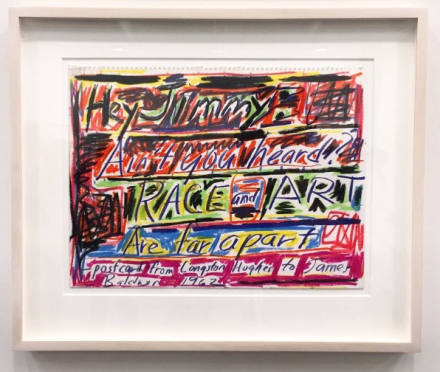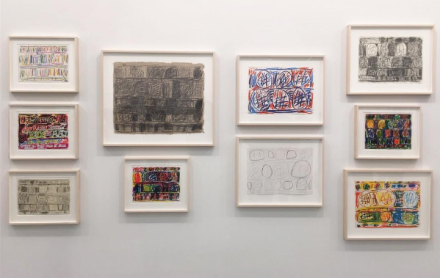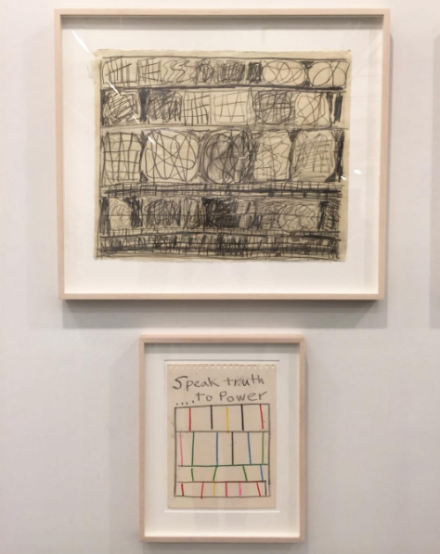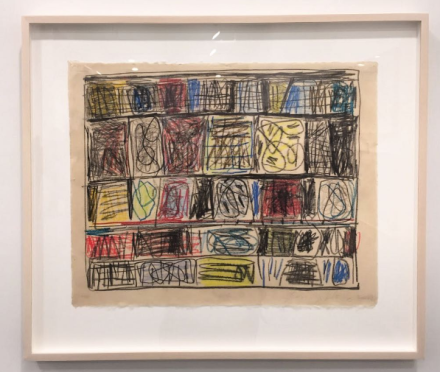
Stanley Whitney, Drawings (Installation View), via Art Observed
Lisson Gallery’s second New York location kicked off the fall art season this past week with a striking exhibition of drawings and small-scale works by Stanley Whitney, a charged entry in the season’s landscape of exhibitions that rings a powerful chord against the backdrop of the U.S.’s turbulent and increasingly violent, racially-tinged struggles. Spread across the walls of the gallery’s small project space, the show is an impressive entry in the artist’s oeuvre, combining his energetic, colorful sensibilities with a more cutting socio-political and critical lens, one that brings his work into tight focus against the backdrop of current events.

Stanley Whitney, Drawings (Installation View), via Art Observed
Whitney’s work, long-known for its close-cropped blocks of surging, dense color fields, sits at a striking intersection of techniques in the evolution of American abstraction. His canvases explode with deep reds and blues, arranged with careful consideration and a sense of contrast that makes his work all the more concise and powerful. Yet the artist’s drawings serve as an equally vital aspect of his practice, allowing him to experiment with lines of movement, and twisting, serpentine patterns often reserved for the paper page rather than a large-scale piece. True to form, these pieces seem to draw additional strength from their small-scale and limited space, allowing the artist enough space to double back and work through forms and lines again in various iterations and variations, as if improvising on a theme. In one untitled piece from 1990, his initial, circular tracings become zones for frequent collisions of line and color, movements that seem to both serve as the underlying structure of his larger works, and equally as elaborations on many of his gestural techniques.

Stanley Whitney, Drawings (Installation View), via Art Observed
Yet Whitney’s works here equally present a more cutting tone, frequently dwelling on cultural themes like black mass incarceration, violence and racial discrimination, often bearing concise phrases and quotes that challenge his work’s direct reading as experiments in space and composition. “Ain’t you heard? Race and Art are far apart” reads one, attributing the line to Langston Hughes addressing James Baldwin. In another, the phrase “speak truth to power” is countered by a spare series of bars resembling a jail cell, an ominous note that breathes new life into Whitney’s spatial arrangements.

Stanley Whitney, Drawings (Installation View), via Art Observed
As much as one can read his work as direct responses to the canon of American abstraction, these drawings offer additional wrinkles and folds to his practice, concepts that underscore his interest not only in tightly arranged grids as a compositional form, but perhaps as a broader metaphor for life itself. Much as Whitney’s work seems to place a special emphasis on the life between these hard lines and limits on his painterly energy, and here, even on the possibilities of moving within, outside, or through these spatial constraints. For even as Whitney is willing to draw the bars he labels himself as forces of oppression and division, his work traces possibilities for a vivid life lived as if they were only tools for artistic play.
The exhibition is on view through October 21st.

Stanley Whitney, Drawings (Installation View), via Art Observed
— D. Creahan
Read more:
Stanley Whitney: “Drawings” [Lisson Gallery]



